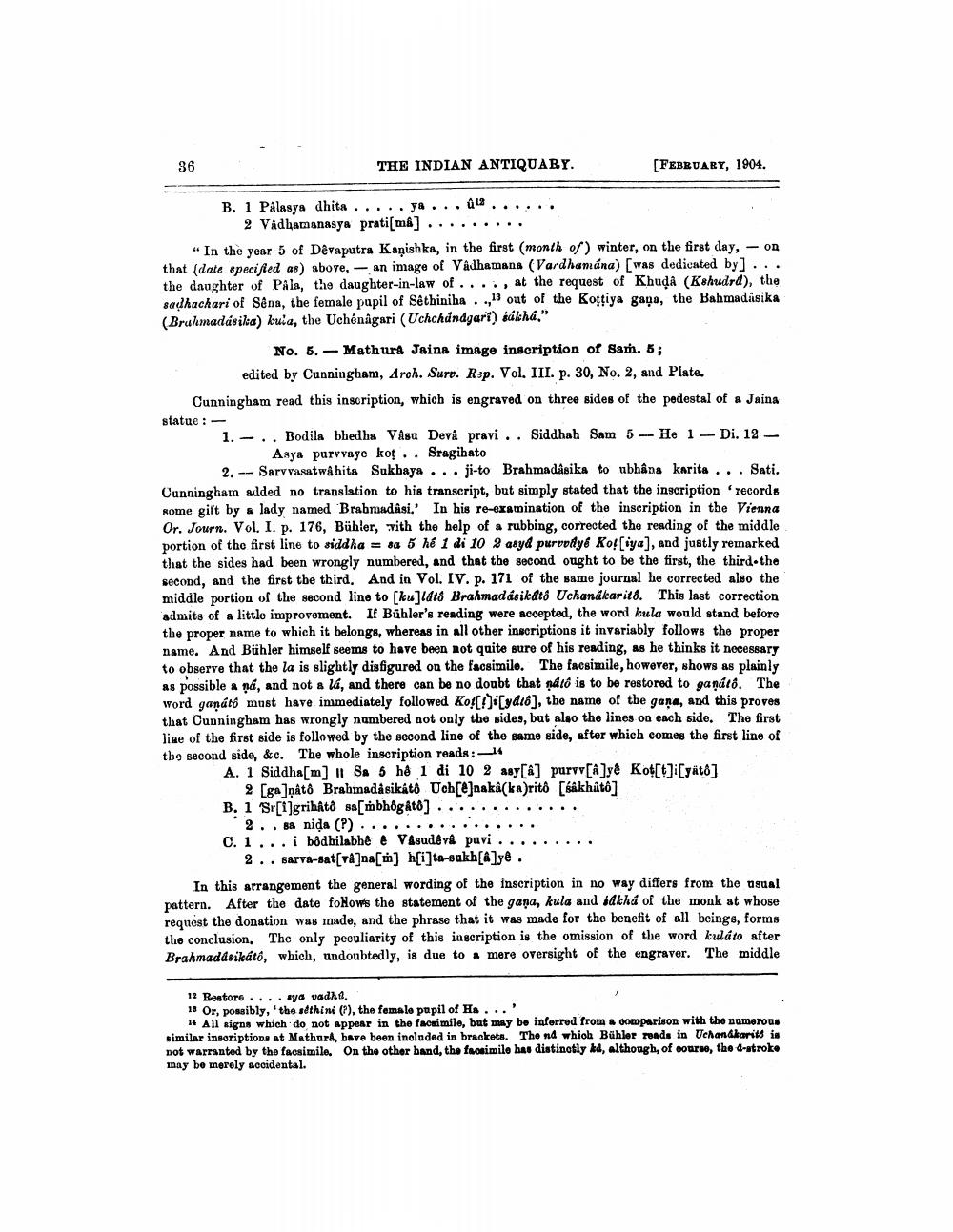________________
36
THE INDIAN ANTIQUARY.
[FEBRUARY, 1904.
B. 1 Palasya dhita ..... ya... 01......
2 Vadhamanasya prati[ma] ......... - In the year 5 of Dêvaputra Kanishka, in the first month of) winter, on the first day, - on that (date specified as) above, - an image of Vâdhamana (Vardhamána) (was dedicated by]... the daughter of Pala, the daughter-in-law of ...., at the request of Khuda (Kshudrd), the sadhachari of Séna, the female papil of Séthiniha..,13 out of the Kottiya gayo, the Bahmadasika (Brulmadásika) kuia, the Uchênågari (Uchchándgari) sakha,"
No. 6. - Mathura Jaina image inscription of Sam. 5;
edited by Cunningham, Aroh. Suro. Rep. Vol. III. p. 30, No. 2, and Plate. Cunningham read this inscription, which is engraved on three sides of the pedestal of a Jaina statue : -
1.- .. Bodila bhedha Vasu Devå pravi . . Siddhah Sam 5 -- He 1 - Di. 12 -
Asya parvvaye koț . . Sragibato
2. -- Sarv vasatwa hita Sukbaya ... ji-to Brahmadásika to ubhana karita ... Sati. Cunningham added no translation to his transcript, but simply stated that the inscription records rome gift by a lady named "Brabradasi.' In his re-examination of the inscription in the Vienna Or. Journ. Vol. I. p. 176, Bühler, with the help of a rubbing, corrected the reading of the middle portion of the first line to siddha = sa 5 hé 1 di 10 2 asyd purvody Korsiya), and justly remarked that the sides had been wrongly numbered, and that the second ought to be the first, the third the second, and the first the third. And in Vol. IV. p. 171 of the same journal he corrected also the middle portion of the second line to [ku]lat8 Brahmadásikdtd Uchanákarit. This last correction admits of a little improvement. If Bühler's reading were accepted, the word kula would stand before the proper name to which it belongs, whereas in all other inscriptions it invariably follows the proper name. And Bühler himself seems to have been not quite sure of his reading, as he thinks it necessary to observe that the la is slightly disfigured on the facsimile. The facsimile, however, shows as plainly as possible a ņá, and not a lá, and there can be no doubt that ņdtó is to be restored to ganátô. The word ganátó must have immediately followed Ko[:)*[yd16], the name of the gaña, and this proves that Cunningham has wrongly numbered not only the sides, but also the lines on each side. The first line of the first side is followed by the second line of the same side, after which comes the first line of the second side, &c. The whole inscription reads:
A. 1 Siddha[m] I1 SA 5 hê 1 di 10 2 asy[á] purvv[A]y& Kot[t]i[yatd]
2 [ga]nâtô Brahmada sikátó Uch[@Jaska(karitô [akhito] B. 1 Sr[i]grihátð sambhog átd] ..
2.. Ba nida (P) ............... C. 1... i bôdhilabhê & Vasudeva pavi .........
2.. sarva-sat[vâ]na[m] h[i]ta-sakh[@]ye. In this arrangement the general wording of the inscription in no way differs from the usual pattern. After the date fo How's the statement of the gana, kula and ádkhá of the monk at whose request the donation was made, and the phrase that it was made for the benefit of all beings, forms the conclusion. The only peculiarity of this inscription is the omission of the word kuláto after Brahmaddsikátô, which, undoubtedly, is due to a mere oversight of the engraver. The middle
12 Restors .... sya radhi 13 Or, possibly, the sethini (?), the female pupil of Ha...
# All signs which do not appear in the facsimile, but may be inferred from a comparison with the numerous similar insoriptions at Mathura, bave been included in brackets. The nd whiola Bühler roads in Uchandkarits is not warranted by the facsimile. On the other hand, the frosimile has distinctly kd, although, of course, the d-stroke may be merely accidental.




